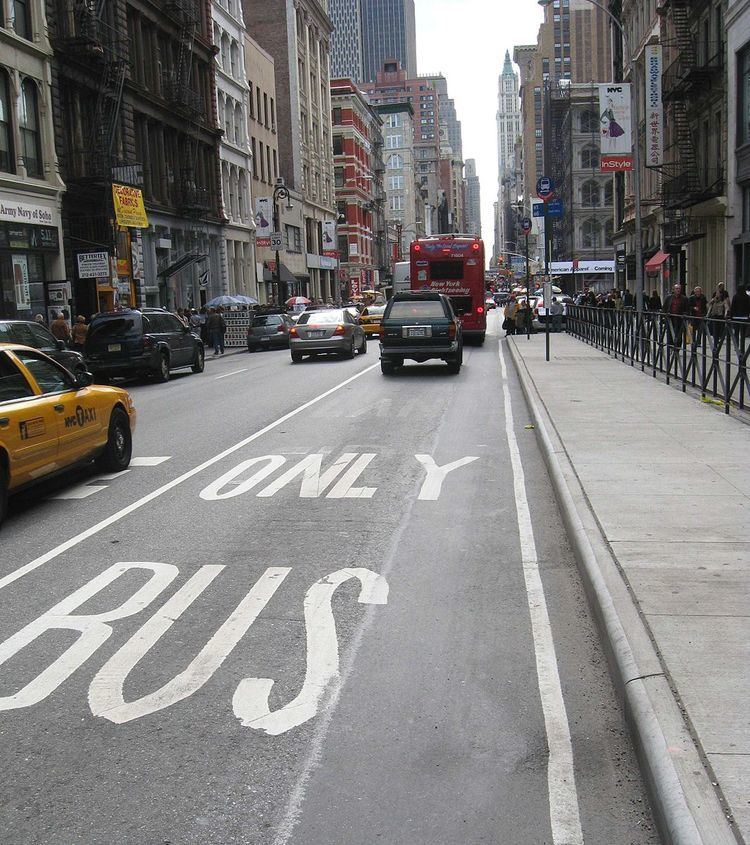 | ||
New York City has a system of bus lanes that are intended to give priority to buses, which contain more occupants than passenger and commercial vehicles. In 2010 the city began enforcing the rule by placing cameras that take photos and videos of violators. There have been controversies on the legitimacy of the bus lanes due to the resulting increased traffic and the methods used to enforce bus lanes during their operating hours.
Contents
Types of bus lanes
A curbside bus lane is a bus lane that runs along the curb. Vehicles are not allowed to park or stand this lane.
An offset bus lane is a bus lane that is one lane away from the curb. In this setup, vehicles are able to park or stand at the curb, but are not allowed to double park or stop on the bus lane.
Notable corridors with bus lanes
The main routes on these corridors are listed.
Rules
Emergency vehicles and buses are the only vehicles with unrestricted access to the bus lane during the hours that the bus lane is in effect. During that time, it is permitted to enter a bus lane and drive for a maximum of 200 feet (61 m) in order to make an immediate right turn, or to enter a driveway. It is also permitted to be in the bus lane to actively engage in curbside parking. Finally, delivery trucks can enter bus lanes to make drop-offs or pick-ups at residences or businesses, but only when bus lanes are not in effect.
Enforcement
In 2010, the city gained authorization from the state to begin placing hidden traffic cameras on gantries above the bus lanes. The cameras take photos of the vehicles driving through the bus lane, along with their license plates. A fine of $115 to $150 is then mailed to the registrant's address. The New York City Police Department also enforces the bus lanes by issuing parking and moving violations to violators. In 2014, according to the Independent Budget Office, 3⁄4 of bus lane violations were captured on camera, contributing to $41 million worth of traffic violations captured by traffic cameras in that year.
Automated cameras have advantages over manual police enforcement because they don't make errors, are not disputable, free the police for more important issues, and add revenue to the city without the cost of human officers. However, there were cases where the cameras were reported to be used as traps and the legitimacy was disputed. Another disadvantage was that some drivers received violations for momentarily entering the bus lane to avoid a collision, or taking too long to exit the bus lane as a result of traffic jams.
Prior to installing the bus lane cameras, there were disputes between the MTA and the City of New York over who will get the revenue from the tickets. At first the MTA refused to allow the cameras until the city would agree to split the revenue. The city regularly reports revenue from violations issued by the automated cameras. In one instance a camera issued nearly 7,200 violations in a two-month period, translating to an average of 115 tickets a day, and raising about $823,000 in fine revenue.
Controversies
While bus lanes reduce the time for bus commuters, it creates traffic jams and increases travel time for other vehicles. On one bus lane, some drivers reported that travel times had more than doubled, and residents reported increased honking and pollution, despite a study by the NYCDOT indicating that there would not be increased traffic for other vehicles. The cameras allow for a temporary stop to pick up/drop off passengers at curbside bus lanes, but cab drivers are concerned that customers may take longer than usual to arrange payment, which may result in a fine.
In one incident in 2014, the city delayed mailing out the violations for a few months, causing violators to receive multiple tickets that added up to as much as $7,000. According to one commentator for The New York Times, this did not serve the purpose of the cameras, which were to educate drivers and keep the bus lanes empty of cars. The city agreed to review the violations and to keep each driver liable only for the first violation they received. There was a bus lane camera on Staten Island that gave tickets to drivers who failed to make an immediate right turn, even though it was not possible to make the right turn, since the next possible turn was a private driveway or a one-way street that had traffic running in the opposite direction. One retired police officer showed that his ticket was withheld by the judge and the appeals system. The city eventually turned off the camera.
